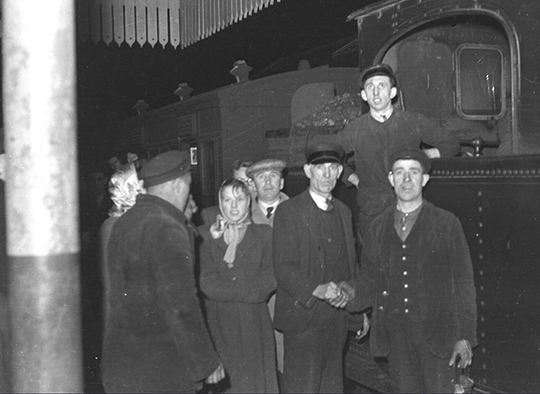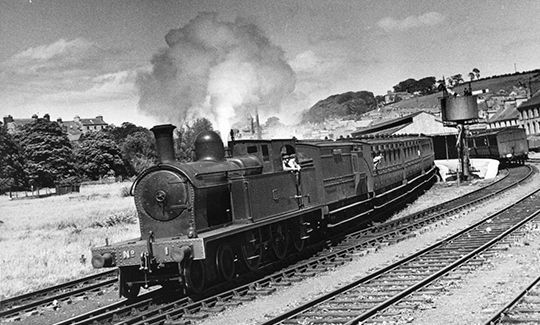Seventy years ago this morning 70 years ago the first part of Northern Ireland’s railway network literally came to the end of the line, with the axe falling on a large part of the old Belfast and County Down Railway, marking the end of 100 years of railway transport in East Down writes Robert Gardiner, chair of Downpatrick and County Down Railway.
On this day (15th January) in 1950, railway stations south of Comber fell quiet and an eerie silence descended upon mile after mile of what had once been a key transport corridor
Mr Gardiner said: “No longer would the rumble of trains and passenger-filled carriages pass through on their way to Castlewellan or Newcastle, stopping at Ballygowan, Saintfield, Ballynahinch junction, Crossgar, or Dundrum on the way, or perhaps branching off after Downpatrick for Ardglass.
“Later that year, on April 22nd, 1950, services from Belfast to Comber – with stops at Bloomfield, Neill’s Hill, Knock, Dundonald and on to Donaghadee also ceased.”

Today the railway in Downpatrick is a heritage railway set up on the former Downpatrick BCDR terminus. The line survived to today, and would form a vital transport link between the commuter belt into the Northern Irish capital.
“It seems incredible today to think that such a vital transport link could be easily discarded,”added Mr Gardiner, “but in 1950 the ministers in the devolved Stormont Government took the view that railways were as obsolete as the stagecoach.
“In a way, they were right that the lines were Edwardian relics – and the BCDR in particular still operated obsolete Victorian carriages – but investment since then in new technologies in track, signalling and rolling stock over those years have showed what we could have had throughout Northern Ireland.
“But even then, in 1948 an express train from Comber to Belfast could get you into the old Queen’s Quay station near the Odyssey arena in 15 minutes – despite the investment in the Glider and other public transport initiatives, nothing has come close to replicating that speed and efficiency.”
“Up to the 1940’s, the main railway network in Northern Ireland was operated by three major railway companies, the London Midland and Scottish Railway’s ‘Northern Counties’ lines, which operated out of York Road Station to Larne and Londonderry; the Great Northern Railway of Ireland, which operated out of Great Victoria Street Station to places like Dungannon, Armagh, as well as Dublin; and the Belfast and County Down Railway, based at Queen’s Quay Station.”
In 1948, the Stormont government decided to nationalise the network and amalgamate the LMS and BCDR with the bus operator, the Northern Ireland Road Transport Board, to form the Ulster Transport Authority, a predecessor to Translink.”

Robert explained: “A tribunal was set up to consider how this could be best achieved and provide an integrated transport system. Rail chiefs, who had been hoping for investment after the railways had proved so crucial to the war effort a few years earlier and that the buses would be barred from competing with the trains and instead provide a feeder service to stations, were devastated at the outcome.
“The recommendation, accepted by Stormont, was that the entire Belfast and County Down Railway main line from Belfast to Newcastle, including the branches to Donaghadee, Ballynahinch and Ardglass, should be closed.
“The only route to be saved was the Belfast to Bangor connection, which continues operating successfully to this day.
“The attitude of Stormont was that it would be cheaper to move everything to the roads than to invest in railways that had been run down during the Second World War – people would use the buses instead. They developed huge road building schemes – most were never completed – but closed the railways first before these were even started. It seems incredible today.
“The most puzzling element of the decision was the axing of the Belfast to Newtownards line, which served the east of the city – Dundonald, Knock and Comber areas in which the suburbs were developing and likely to provide increased commuter traffic had they been spared.”
“Indeed, there were more than enough new diesel trains ordered to operate both the Bangor and Newtownards lines – and evidence suggests that the Transport Tribunal expected Stormont to spare the Comber line as a compromise option and as late as 1953 before the tracks were lifted they were calling on the minister responsible to reverse the decision and trial these new diesel trains on this section of track – a call that fell on deaf ears”.
The 1950 closures were the first steps in a plan which was to see the reduction of the Northern Ireland’s railway network from 754 miles to 297 miles, a decrease of 61 per cent.

A decade later, the Great Northern Railway was divided between the UTA and its counterpart in the Republic, CIE, and further closures to lines to Armagh, Dungannon, Omagh and Strabane occurred. Mr. Gardiner added: “These closures all occurred before the infamous Beeching Report into British Railways – the remit of which did not extend to Northern Ireland as this was a devolved matter. However, I often say to our visitors ‘Beeching learned from Stormont’.”
Willie Watterson and James Magill, who were a porters and ticket clerks at Newcastle and Tullymurry stations, recalled his memories of the last train in an interview recorded for the BBC documentary ‘Raising Steam’ in 2007
“The last train was a Sunday night. It was a cold winter night, 15th January 1950. There was twelve coaches, and two engines and two Guards. She was packed. Packed to the doors. So I lit all the lamps, and put detonators on the line to give her a send-off.
James added: “I think every station did the same thing, so when the train came in there was a salute of bangs. I felt terrible about it, terribly terribly sad. I still felt it couldn’t happen. Still felt they’ll come back, they’ll run again. I couldn’t believe there’d be no more railways, after working on them so hard”
Adam Hamilton, who was a fireman (the person who stoked the fire on the steam locomotives), also explained: “It broke my heart, because the railways were in my blood. I still hear the sound of the steam still running on a clear night puffing away”.
Today, the Downpatrick & County Down Railway keeps the memory alive through its reconstruction of two miles of the former main line as well as restored carriages rescued from their fate as hen houses.
As part of its commemorations of the BCDR’s demise, it is keen to make contact with anyone who had any connection with the network, including former employees or their families, or people in possession of railway memorabilia such as photographs, tickets, timetables or even carriages.
Mr Gardiner said: “One thing we would love for the museum is a BCDR uniform or tunic. So far we have been unable to track one down. Perhaps you may have something in your loft?”
The Downpatrick & County Down Railway can be contacted via email at:
or message at: www.facebook.com/downrail
And what of the future of the line? In November 2008 the section of the BCDR’s former main line from Holywood Arches to Comber was opened as the Comber Greenway, whilst other sections have been used for roads as well as the section around Downpatrick being used by the DCDR.
In the early 1990’s Northern Ireland Railways prepared a feasibility study into reopening the line to Newtownards, but this was not taken further by the Direct Rule administration.
In May 2013, the Department for Regional Development published its Railway Investment Prioritisation Strategy, which promised feasibility studies into the reopening of closed railway routes to Armagh, Dungannon and Castledawson by 2030, but not including the Comber/Newtownards route.
“However, and maybe,” mused Robert Gardiner: “Seventy years after in Northern Ireland, the new Minister for Infrastructure in the restored Stormont Government might see the first of those historic mistakes rectified.”

























